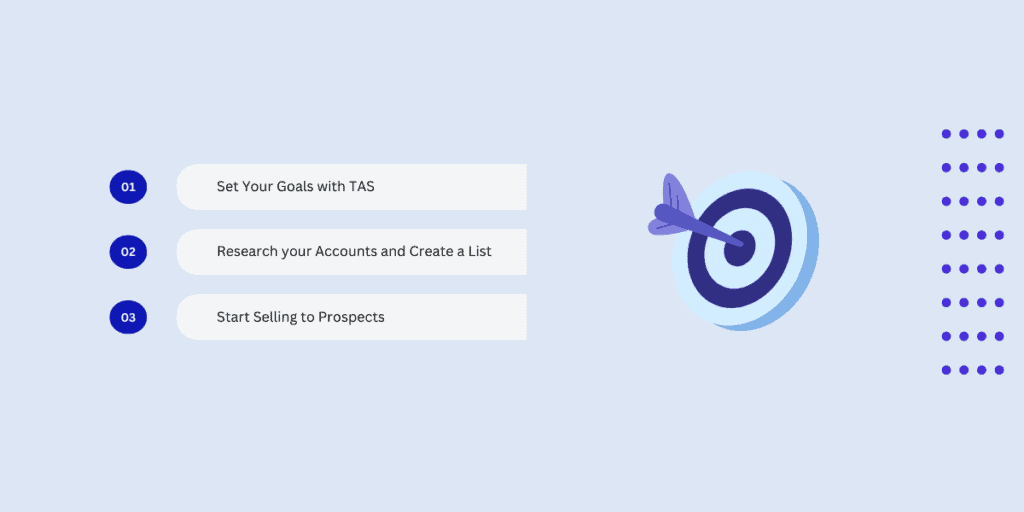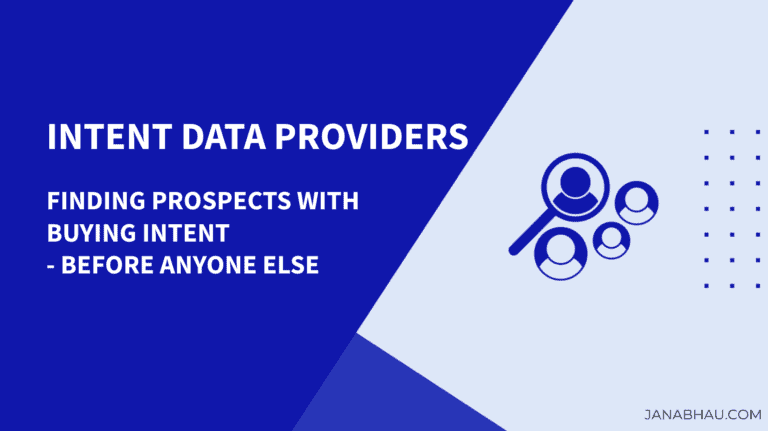Master Target Account Selling: Strategies for Success

Target Account Selling (TAS) helps sales teams focus on high-value customers through personalized and strategic engagement.
Unlike traditional sales methods that cover a broad audience, TAS aims at specific accounts with the highest potential.
This article will help you understand what TAS is, why it works, and how you can use it to boost your sales performance.
Key Takeaways
- Target Account Selling (TAS) is a focused B2B sales strategy that prioritizes high-value customer accounts through personalized communication, enhancing engagement and conversion rates.
- The benefits of TAS include stronger client relationships, higher annual contract values, more efficient resource allocation. At the same time, challenges involve significant time investment in research and the potential for missing other opportunities.
- Implementing TAS requires setting clear goals, conducting thorough account research to create targeted lists, and engaging in personalized outreach using buyer intent tools to build relationships and address specific client needs.
What is Target Account Selling?

Target Account Selling (TAS) is a way for businesses to focus on selling to their best potential customers. Instead of trying to sell to everyone, TASe helps sales teams find and talk to the most valuable customers using personalized communication.
Unlike other sales methods that try to reach many people at once, TAS focuses on specific businesses or organizations that match the ideal client profile (ICP). This change from a broad approach to a more targeted one lets sales teams connect with prospects in a deeper and more meaningful way, making TAS an effective strategy.
The main part of targeted account selling is carefully picking which customers to target. These customers are chosen based on:
- Deal value
- Industry
- Revenue
- Pain points
By focusing on these details, TAS makes sure every sales effort is aimed at customers with the highest chance of success. Following a target account selling strategy not only makes sales teams work more efficiently but also improves the quality of their interactions with customers.
Benefits and Challenges of Target Account Selling
Target Account Selling (TAS) is attractive because it promises better client relationships and bigger annual contracts. But, like any strong sales strategy, it has its own challenges.
Benefits of TAS
One of the primary benefits of TAS is the ability to foster deeper relationships with clients. By focusing on a select number of high-value accounts, sales teams can:
- Spend more time understanding each client’s unique needs and preferences
- Provide dedicated attention to strengthen client relationships
- Position the sales team as trusted advisors, rather than just vendors
By concentrating on bigger deals and leveraging data analytics to prioritize efforts, sales teams can achieve these benefits. The collaborative effort between sales and marketing teams in TAS drives faster revenue growth and maximizes the impact of each engagement. This focused approach also allows for more efficient resource allocation, ensuring that every effort is directed towards high-potential accounts.
Challenges of TAS
Even though TAS has many advantages, it also faces some challenges.
- Time-Consuming Research: One big challenge is the amount of time and work needed to find the best leads. Doing thorough research to pick out the most valuable accounts can take a lot of time. This can mean there’s less time available to actually make sales. Finding the right balance between research and selling is really important for TAS to work well.
- Narrow Focus on Specific Accounts: Another challenge is that by focusing so much on specific accounts, there’s a risk of missing out on other opportunities. TAS aims to target the most promising prospects, but sometimes this focus means other good opportunities are overlooked. Sales teams might wait for the perfect account that meets all their criteria, which could mean they pass up on other chances to make sales.
- Timing and Readiness of Target Accounts: Also, even if a company identifies the perfect target accounts, those accounts might not be ready to buy right away. It’s important to keep a steady flow of potential clients and build relationships with them over time. But this process can be tough.Some organizations struggle to fully adopt TAS because it requires a lot of nurturing relationships, which can be harder for teams used to more traditional ways of selling.
Step-by-Step Instructions to Target Account Selling

Now that we have explored the benefits and challenges of TAS, let’s dive into the step-by-step process of implementing this powerful sales strategy. From setting clear goals to researching accounts and finally engaging with prospects, each step plays a vital role in ensuring the success of your TAS efforts.
Set your Goals with TAS
The first step in implementing TAS is setting clear and specific objectives. Before you start, it’s important to define what you aim to achieve with your TAS strategy.
Whether it’s signing new accounts, closing deals faster, or upselling existing accounts, having clear goals provides direction and benchmarks for success. Writing down these objectives helps maintain focus and ensures that every action aligns with your overarching sales goals.
Accelerating the sales cycle and maximizing revenue growth by targeting high-value accounts should be primary goals in TAS.
By clearly defining these objectives, sales teams can prioritize their efforts and resources effectively, ensuring that they focus on accounts that are most likely to convert. This clarity not only streamlines the TAS process but also helps measure your strategy’s success over time.
Research your Accounts and Create a List

Once your goals are set, the next step is to research potential accounts and create a target list. This involves thoroughly analyzing firmographic data, tech stacks, past interest in your product, and other relevant information to align with your ideal customer profile. Utilizing platforms like LinkedIn Sales Navigator to find companies and decision-makers that fit your ICP is crucial.
Historical data and segmentation strategies also play a significant role in identifying high-value accounts for your TAS list. The creation of a target account list is a collaborative effort between cross-functional teams. Sales and marketing teams must work together to ensure that the accounts selected align with the characteristics documented in the ICP.
Detailed buyer personas should be created for each decision-maker within the targeted accounts. These personas include:
- Job titles
- Responsibilities
- KPIs they get measured on
- Challenges they face
- Value prop
By understanding these nuances, sales teams can develop personalized outreach campaigns tailored to each account’s unique needs and preferences.
Start Selling to Prospects
With your target account list, it’s time to start selling to prospects. The key to successful TAS lies in personalized outreach and continuous engagement. Finalizing your list and using proven frameworks to personalize outreach efforts is essential. Some tips for successful TAS include:
- Personalize your outreach efforts using insights from LinkedIn and other prospecting tools
- Prospect on multiple channels such as phone, email, social, and physical events to build relationships
- Monitor and track prospect engagement to identify the most promising leads
By following these tips, you can increase your chances of success with TAS.
Sales professionals should address prospects with messages that directly address the specific pain points of each targeted account.
Utilizing data sources such as data enrichment tools, buyer intent data providers, Linkedin, and insights from your CRM can inform your approach and ensure your communications are highly relevant and personalized.
By continuously engaging with potential clients and building relationships over time, sales teams can increase their chances of converting high-value accounts.
When is the Right Time To Implement Target Account Selling?
Implementing TAS is most effective when dealing with:
- Complex deals that involve multiple decision-makers
- Scenarios that require deep research and cross-departmental coordination between marketing, sales, and customer success teams
- Clients interested in long-term collaboration, where significant lead generation and audience research are required early on.
Target Account Selling Strategies You Can Follow

Several strategies can be followed to successfully implement TAS.
- Research Your Targets:
- Dive deep into each target account to understand their specific needs and challenges.
- Use this insight to tailor your approach and make your pitch relevant.
- Personalize Your Outreach:
- Customize your messages and presentations to address the unique pain points of each account.
- Make sure your approach feels personal and specific.
- Engage Through Multiple Channels:
- Use a mix of email, social media, and industry events to reach key decision-makers.
- This multi-channel approach helps you connect more effectively.
- Involve Top Executives for High-Value Accounts:
- For important accounts, consider having executives participate in meetings.
- This helps build stronger relationships and trust.
- Highlight Value and ROI:
- Focus on the potential return on investment (ROI) your solution offers.
- Share relevant case studies and examples to show the impact.
By following these strategies, you’ll be better positioned to target key accounts and achieve successful outcomes.
Target Account Selling Examples?

Let’s say a company called “TechSolutions” is trying to win over a major client, “Innovative Corp.” To effectively use Target Account Selling strategies, TechSolutions would start by thoroughly researching Innovative Corp. to understand their specific needs and challenges.
For instance, they discover that Innovative Corp. is struggling with ineffective internal communication. Next, TechSolutions tailors their outreach by crafting a presentation that addresses these exact pain points, making their pitch feel highly relevant.
They also engage through multiple channels—sending personalized emails, connecting on LinkedIn, running targeted ads, and inviting decision-makers to a webinar on best practices for internal communication.
To further build trust, TechSolutions involves their CEO in high-level meetings with Innovative Corp.’s top executives, aligning their solution with the company’s strategic goals.
Finally, they highlight the potential return on investment (ROI) by sharing case studies from similar companies and providing customized ROI calculations. By following these strategies, TechSolutions maximizes their chances of securing the deal with Innovative Corp.
Key Considerations For Successfully Implementing TAS?
Successful implementation of TAS requires:
- A deep understanding of the ideal customer and their specific needs
- Aligning sales and marketing efforts towards the common goal of winning business from target accounts
- Building relationships with key decision-makers within target accounts
Effective TAS involves a coordinated approach involving research, relationship building, and creating value for potential clients. Using accurate and up-to-date customer data to tailor sales strategies is crucial for success.
Alternatives to Target Account Selling
While TAS is a powerful sales strategy, it’s not the only approach available. Alternatives such as Account-Based Marketing (ABM) and Solution Selling offer unique advantages and can complement TAS in different scenarios. Understanding these alternatives can help you choose the best strategy for your organization’s needs.
Account-Based Marketing (ABM)
Account-Based Marketing (ABM), also known as account-based selling (ABS), overlaps with the Target Account Selling methodology. ABM involves:
- Personalized email campaigns
- Targeted advertising
- Engaging key decision-makers within target accounts
- Leveraging business intelligence tools and marketing data
- Creating hyper-personalized sales campaigns that resonate with high-value accounts
ABM’s focus on personalized outreach and targeted advertising makes it a powerful alternative to TAS. When companies align sales and marketing teams and use accurate account-specific data, they can increase customer retention and drive revenue growth. This strategy is particularly effective for businesses building long-term relationships with key accounts.
Wrapping Up and My Experience With Target Account Selling
Target Account Selling (TAS) has been a game-changer in my sales career. By focusing on identifying, qualifying, and pursuing high-potential accounts, I’ve been able to maximize revenue impact and build long-term relationships with clients.
Aligning sales efforts with marketing and customer success teams has not only streamlined our sales process but also led to larger deal sizes, shorter sales cycles, and higher win rates. However, it’s important to acknowledge that the success of TAS hinges on a mature data strategy, clear sales goals, and internal team alignment.
Implementing TAS can be challenging, particularly due to the time-consuming research process and qualifying accounts. But with a strategic approach and the right tools, these hurdles can be overcome, leading to a successful target account selling initiative.
My experience with TAS has been overwhelmingly positive, resulting in significant business growth and a deeper understanding of our clients’ needs. I encourage you to explore TAS and see how it can transform your sales efforts.
Frequently Asked Questions
What is Target Account Selling (TAS)?
Target Account Selling (TAS) is a B2B sales strategy that focuses on identifying and engaging high-value customer accounts with personalized communication, prioritizing specific businesses or organizations that closely align with the ideal client persona for targeted and efficient sales efforts.
What are the main benefits of TAS?
The main benefits of TAS include deeper client relationships, higher annual contract values, faster revenue growth, and efficient resource allocation, leading to improved customer satisfaction and shorter deal closure times. These advantages enable sales teams to focus on high-value accounts and enhance overall business performance.
What challenges might I face when implementing TAS?
You may face challenges such as significant time and effort investment, risk of overlooking opportunities, and difficulty in nurturing clients. Extensive research and balance between research and selling are crucial in overcoming these challenges.
How do I set goals for TAS?
To set goals for TAS, define clear objectives such as signing new accounts, closing deals faster, and upselling existing accounts. Writing down specific objectives helps maintain focus and ensures that every action aligns with overarching sales goals.
What are some alternatives to TAS?
Some alternatives to TAS are Account-Based Marketing (ABM) and Solution Selling, which involve personalized email campaigns, targeted advertising, and identifying customer pain points to offer customized solutions, offering unique advantages in different scenarios.




![11 Best Data Enrichment Tools Using AI [2024]](https://janabhau.com/wp-content/uploads/2023/11/White-Blue-Professional-Modern-Best-Way-To-Earn-Money-From-Home-Blog-Banner-5-768x432.png)

![How Data Enrichment Transforms Sales & Marketing Activities [+Best Practice]](https://janabhau.com/wp-content/uploads/2024/02/Feature-Images-5-768x432.png)